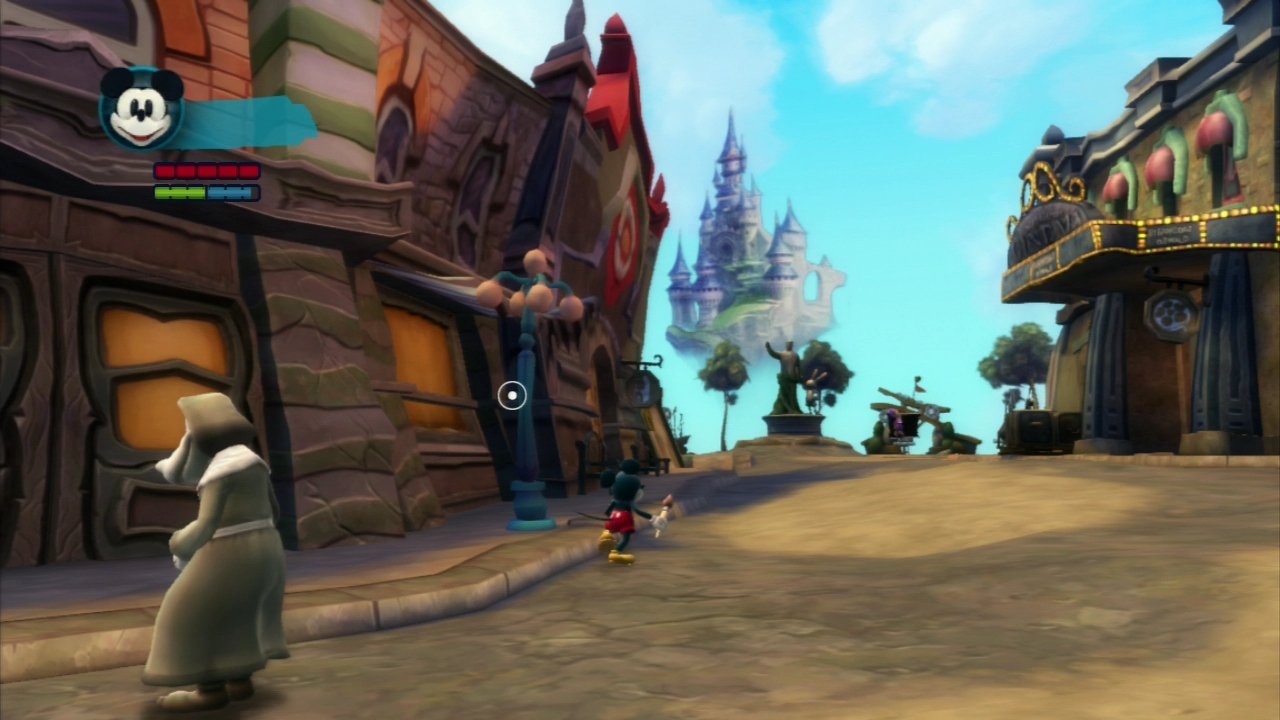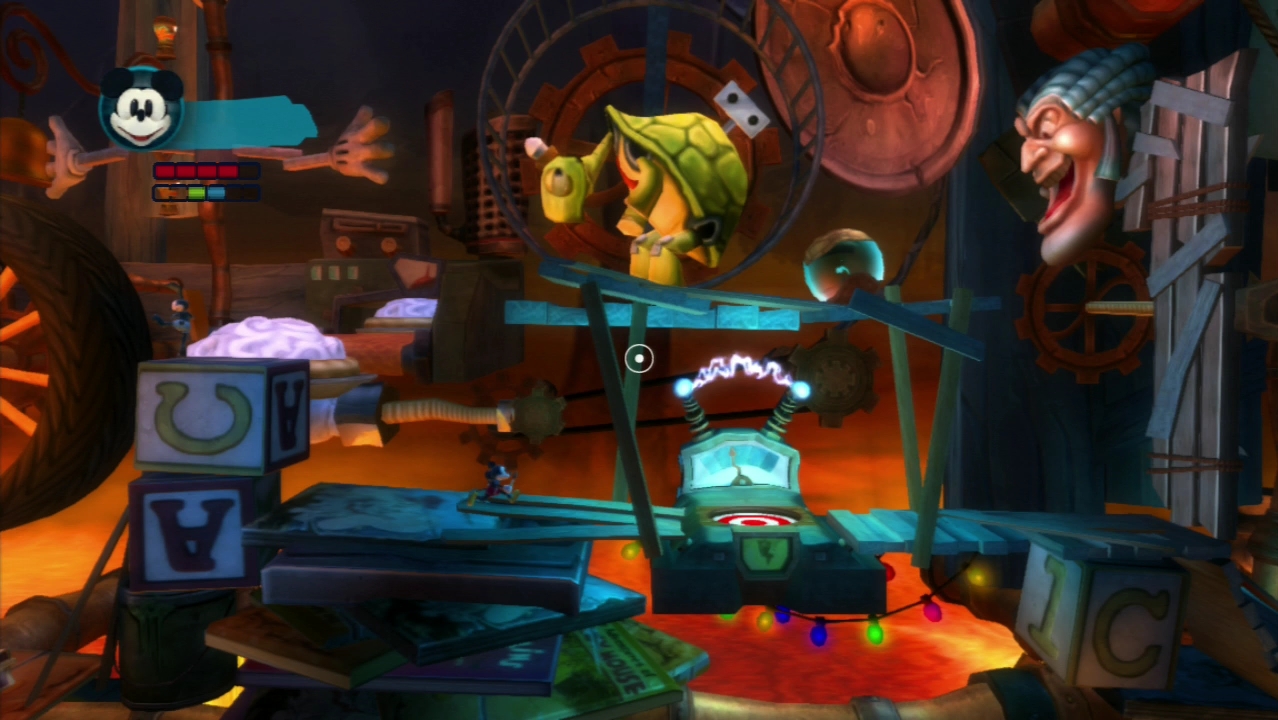Epic Mickey 2: The Power of Two centers on intertwined themes of creation and destruction. Wielding a magical paintbrush, Disney's mascot runs through the crumbling Wasteland, conjuring pieces to make whole the fragmented land or erasing the few structures that still stand tall. Relationships are forged while others are shattered, and it's your choice whether you breathe life into Wasteland or let it sink further into disrepair. Lovable characters and iconic imagery urge you to take the high road, to create rather than destroy the elements that make up this magical kingdom, but it's impossible to escape the all-encompassing reach of destruction. All of your joy, and the effusive happiness the game exudes, is crushed under the avalanche of debilitating problems that tear Epic Mickey 2: The Power of Two apart.
Before The Power of Two can undermine your hopes, it introduces a story that embodies everything this disappointing game does right. The Mad Doctor swears that he has learned his lesson after years of fiendish scheming, and promises to repair Wasteland after earthquakes have torn the town asunder. Mickey, Oswald, and a cast of lovable characters express cautious optimism that the Mad Doctor has turned over a new leaf, and seeing their hesitant acceptance encourages a forgive-and-forget attitude that encourages even the rottenest people to better themselves. It's a story built on trust, and the intrinsic joy in every aspect of these cutscenes bubbles forth in toe-tapping musical numbers that give this adventure a cheery, happy-go-lucky vibe.
Once unleashed in this world, you have a choice in how you go about fixing up Wasteland. Objectives may nudge you in certain directions, but a wealth of side quests easily distract you for hours on end. Denizens line the Mean Streets, eager for a helping hand, and you must scurry in every mouse hole and hideaway to find the precious collectibles these poor characters desire. Slowly roaming this evocative land as Mickey is where The Power of Two is at its best. Happening upon a quiet burg populated by Captain Hook's most loyal pirates, or meeting Daisy Duck as she investigates mysteries for her television station, shows how lovingly Disney's world was incorporated. The game tugs at your nostalgic desires, which gives more weight to your choice in building up or tearing down this iconic land.

Jealousy tainted the uneasy pairing of Mickey and Oswald in the original Epic Mickey, but those green feelings have fallen by the wayside in this sequel. Now the two travel through Wasteland together, turning a solitary adventure into one that can be experienced cooperatively. Another player can jump in (or hop back out) at any point during the journey, and when you don't have a friend to travel with, Oswald follows right behind you like a distracted AI-controlled dog. But you'll want to take pains to bring a friend along whenever possible, because that discarded rabbit is an active hindrance to your progress when left under computer control.
Oswald has electricity at his fingertips instead of the magical paintbrush, and must use his kinetic powers to defeat enemies and trigger traps. Left to his own devices, he enters frays at his leisure, either conjuring an energy sphere to short-circuit a robotic foe or wandering helplessly nearby, shouting words of pain or confusion without bothering to help in your struggles. You may call him over to solve a puzzle only to have him obstinately disobey, or toss him inadvertently in the air when you just wanted him to zap a fuse box. Jump on a teeter-totter, and he's liable to follow you to the wrong side, thwarting your chance of reaching higher ground, and he has a nasty habit of standing between you and an enemy during combat, absorbing your paint attacks while complaining that you're hurting him. Oswald is a terrible companion, and his uneven implementation is symptomatic of the amateurish mechanics that infect this adventure.
Jumping, the most important element of a platformer, is a clumsy mess that clashes with the cartoony charm the game exudes. A troublesome camera is the most immediate culprit. Unlike in the original Epic Mickey, your view is rarely obstructed by parts of the environment, but that doesn't alleviate the problems. Distorted perspectives make lining up long-distance leaps troublesome, so you're left guessing how far away you actually are, and often plummet unceremoniously to your death. More problematic is that it's difficult to know what surfaces are safe for you to stand on and which will spit you right off. It's all too common to slide right off a seemingly level expanse, while other times you may stand in thin air, not making contact with anything other than clear oxygen. Jumping in The Power of Two is an unpredictable and often frustrating ordeal.
Problems extend to the combat. You can square off against foes in a couple of ways, so you may thin them into nothingness or paint them until they change their allegiance. It's a smart system that often makes you work hard to perform good deeds, but once again, the positive potential is undermined by shoddy mechanics. Collision detection is the biggest problem here. Mickey's damage box is incredibly large, which means that enemies only have to come close to hurt you. You can avoid a missile only to have a heart knocked off, making every encounter a frustrating one. On the flip side, enemies have smaller collision detection. When you jump on top of them or perform a spin attack, you have to be perfect, and that disparity makes fights drag on long after the fun has drained away.
Tedious objectives ensure that even if you can stomach the core flaws that populate this game, it's still difficult to derive any enjoyment from your activities. Boss fights stretch on for an inordinate length of time. In one battle, a powerful airstream pulls you toward a row of spikes, and you have to fight against this suction while shooting a robotic face that's staring you down. After many arduous minutes, you might succeed, only to have to repeat the whole ordeal two more times. There's no skill involved, no evolving strategies; it's just the same tired action repeated ad nauseam. In another section, you must leap to a hidden door while wearing invisible ink. Gus, the unhelpful gremlin, continually urges you to disappear from view, ignoring that you become visible again very easily. You could be stuck in this area for a lifetime, and the easiest way to pass it is to ignore Gus completely and try another method.

The Power of Two falters in all of the most important places, destroying its enormous potential. The musical story and reverential adaptation of classic Disney do an outstanding job of investing you in Mickey's struggles, but the act of playing continually destroys that sense of wonder. It's disappointing that so many of the same problems that haunted the original Epic Mickey are present in the sequel. It's simply not worth suffering through hours of punishing game design to discover the occasional moments of nostalgic joy. Sadly, The Power of Two is another failed attempt at revitalizing Mickey's career.